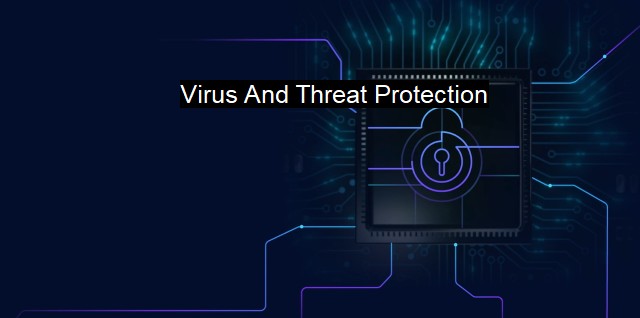What is Virus And Threat Protection?
Why Virus & Threat Protection is Crucial for Digital Safety: Understanding the Significance and Mechanisms of Antivirus Software
Virus and threat protection is a comprehensive setup that provides security and safety for computer systems against a variety of threats such as malware, ransomware, spyware, and phishing scams. The context resides within the realm of cybersecurity and antivirus software, realms critically entrenched in today's technology-dependent society. Virus and threat protection safeguards your data, boosts the resilience of your computer systems, and protects the integrity of personal, confidential and business information.At its core, virus and threat protection encompasses two key components: antivirus software and cybersecurity practices. Antivirus software serves as the first line of defense, barricading computer systems against viral threats and malicious attack campaigns. Such viruses pose significant threats to computer systems by infecting files, reducing system performance and hinder users trying to access their data.
Antivirus software operates by scanning, detecting, and removing viruses within the system. Advanced antivirus software not only offers protection against known viruses but is also equipped with proactive threat-detection analysis. This advanced mechanism allows the software to identify, isolate and disarm potential new viruses and malware based on their behavior and code patterns. this means they can target and neutralize threats that have yet to be officially identified in the cybersecurity world.
Likewise, antivirus software can also help safeguard against ransomware, a intrusive type of malicious software that essentially hijacks system information and files, locking users out from their data and demanding a ransom in exchange for access recovery.
Beyond this software though, virus and threat protection also refers to wider overarching strategies in the realm of cybersecurity. Cybersecurity practices refer to methodologies, frameworks and policies that organizations and individuals implement to secure their digital boundaries. Elevated cybersecurity standards have become particularly pivotal in recent years with an uptrend in business operations shifting to digital platforms and mixing sensitive data within multiple streams of both internal and external communication.
Cybersecurity encompasses networking and developing a secure cyberspace via setting up strong, hard-to-predict passwords, implementing multi-factor authentication where needed, keeping software, particularly the antivirus software, updated and patched, performing regular system audits and backups, and training employees about best practices when online.
Typically, a solid cybersecurity standard extends to using encrypted communication to protect sensitive data, employing a VPN for establishing secure, private connections and periodically purging unnecessary data as an added preventive measure against losses should a security breach happen. A constant vigil is considered ideal for monitoring potential attacks and breaches..
For comprehensive virus and threat protection, organizations may as well integrate the practices of cybersecurity into their daily operations, since a majority of threats originate from human errors such as falling for phishing scams, using weak or guessable passwords or lax handling of sensitive data. Therefore, regular staff training and refreshers about best cybersecurity practices are critical in building an organisation's resilience against cyber threats.
Virus and threat protection is a multi-faceted concept, which hinges upon the effective use of antivirus software, embedded in robust cybersecurity practices and protocols. In today's technologically driven world complete with ever-increasing complexities and global online integration, the significance of competent virus and threat protection measures remains paramount. Investment in robust antivirus software and continuous fortification of cybersecurity practices are pillars of ensuring comprehensive virus and threat protection, safeguarding interested parties from potential detriments, financial losses and abating reputation damage.

Virus And Threat Protection FAQs
What is virus and threat protection?
Virus and threat protection is a cybersecurity feature that helps in detecting and removing any type of malicious software or suspicious files that may harm your computer. It includes antivirus software, firewalls, and other security programs designed to keep your system safe from various cyber threats.Do I need virus and threat protection on my computer?
Yes, it is highly recommended that you have virus and threat protection on your computer to protect against potential cyber attacks. With the increase in the number of cyber threats and malware, having proper security measures in place is crucial to keep your data safe.How does virus and threat protection work?
Virus and threat protection uses various techniques to detect and remove malware from your computer. This includes signature-based detection, behavior-based detection, heuristics, and sandboxing. If any suspicious activity is detected, the program will either quarantine or delete the file. It also includes real-time scanning that constantly monitors your system for any potential threats.Which antivirus software is the best for virus and threat protection?
There is no single antivirus software that is the best for virus and threat protection as different software work differently and cater to varying user needs. It is recommended to research and compare different antivirus programs to find the one that suits your specific requirements. Look for factors such as detection rate, ease of use, and customer support when making your decision.| | A | | | B | | | C | | | D | | | E | | | F | | | G | | | H | | | I | | | J | | | K | | | L | | | M | |
| | N | | | O | | | P | | | Q | | | R | | | S | | | T | | | U | | | V | | | W | | | X | | | Y | | | Z | |
| | 1 | | | 2 | | | 3 | | | 4 | | | 7 | | | 8 | | |||||||